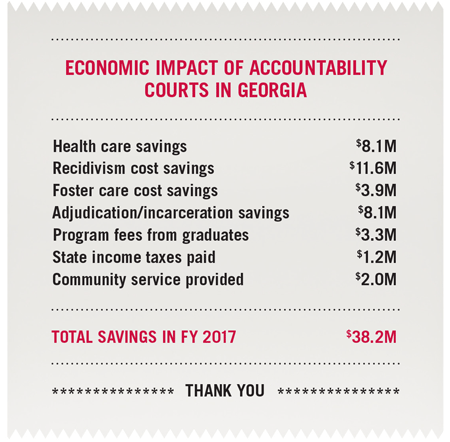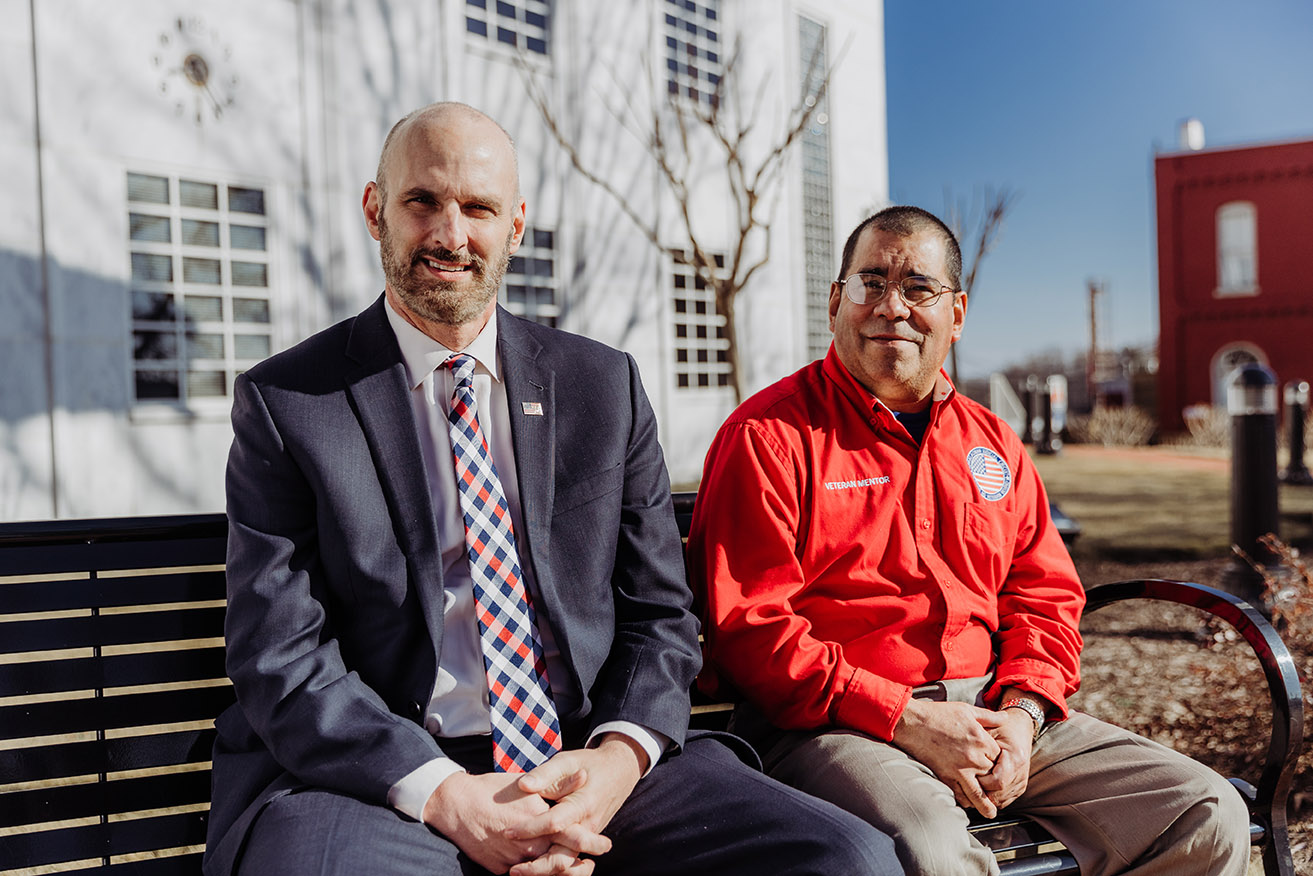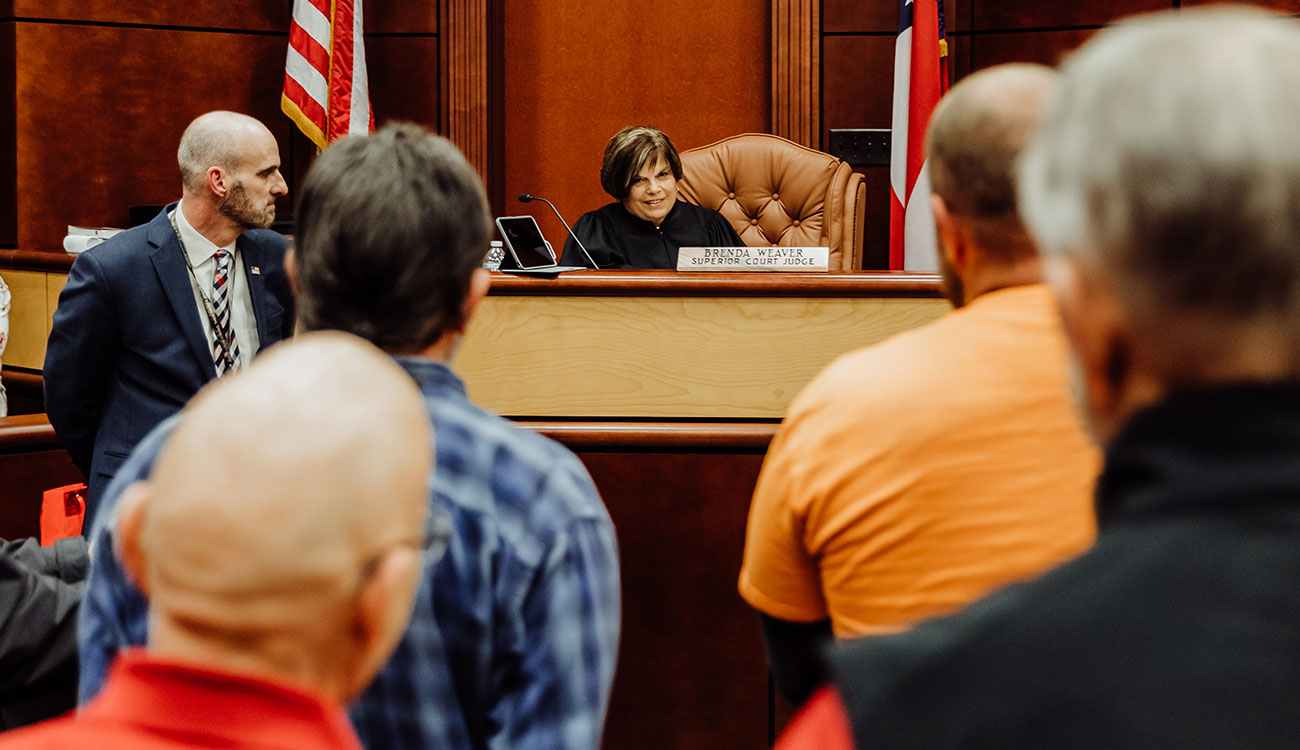Chief Judge Brenda S. Weaver was frequently frustrated with her limited options from the bench.
“Sending individuals, particularly younger men and women, to prison for drug-related issues was so depressing,” says Weaver, who presides over the Appalachian Judicial District spanning Pickens, Gilmer and Fannin counties. “We really didn’t have any alternatives. As a former juvenile court judge, [I thought] it was just wrong. Placing someone with mental health issues into a prison is just mean. We need to exhaust every alternative.”
Weaver saw firsthand the revolving door of adjudication as the same people returned to her courtroom over and over. Once their time was served, opportunities at finding jobs or leading a normal life were limited. They kept falling back into the same trap.
“We were really not providing any type of treatment for them,” she says. “If anyone thinks prison rehabs a person, it’s not … true.”
In 2002, Judge Weaver was one of the early embracers in Georgia of what are known as accountability courts. Instead of incarcerating offenders for nonviolent charges stemming from drug, alcohol or mental health issues, she could sentence them to structured 24-month programs specifically designed to treat those issues while still leading productive lives outside of prison.
“Accountability court gives them an opportunity to get sober, do jobs, be responsible and have some chance at a life,” says Weaver, who currently serves as the chair for the Council of Accountability Court Judges in Georgia. “That’s the key. If we can keep someone in a stable home environment and they’re working, those individuals are less likely to offend again.
“I think it was the best thing, as … a judge, that I’ve ever done.”
“The Council of Accountability Court Judges and the Criminal Justice Coordinating Council … knew how many persons had been diverted from incarceration. What they didn’t have was the data to determine other types of benefits from having persons complete these programs.”
– Wes Clarke, senior public service associate at the Carl Vinson Institute of Government
Research conducted on Georgia’s accountability courts seems to back her assessment. Efficacy studies conducted by Wes Clarke, senior public service associate at UGA’s Carl Vinson Institute of Government, in 2008 and 2015 on the felony drug court in Forsyth County and the DUI court in Hall County showed significant recidivism reduction for program graduates. The 2015 study had a recidivism rate for program graduates of 40 percent—less than half the rate for nonparticipants.
An economic impact study, conducted by the Vinson Institute in 2017, showed the program saved the state $38.2 million a year.
“The Council of Accountability Court Judges and the Criminal Justice Coordinating Council … knew how many persons had been diverted from incarceration,” Clarke says. “What they didn’t have was the data to determine other types of benefits from having persons complete these programs. They may have been a little surprised the number was that large.”
The creation of accountability courts began in the United States in the late 1980s with the intent of addressing overloaded court caseloads and reducing criminal behavior through alternatives to incarceration and probation. It aimed to rehabilitate people facing charges related to drugs, alcoholism and mental illness.
These special courts gradually started appearing in Georgia, mainly as a way to better handle the growing criminal population and better serve individuals charged with crimes based on behaviors that could be changed through mental health treatment.
The first felony drug court in Georgia was established with a federal grant in 1994 in Bibb County. The state’s first DUI courts appeared in 2002 in Chatham, Hall and Clarke counties.
“Judges willing to do it early on were really taking a chance,” Weaver says. “You had to convince district attorneys and … county commissioners to fund it because there was no state money.”
When Gov. Nathan Deal, a former prosecutor and judge, took office in 2011, Georgia led the nation in criminal supervision. At the rate the state was incarcerating offenders, two new adult prisons would need to be built at a reported cost of $264 million.
Deal made criminal justice reform a cornerstone of his policy goals. He drew inspiration from his son, Judge Jason Deal, who presided over drug courts in Hall and Dawson counties. In his 2012 State of the State address, Gov. Deal recommended an additional $10 million in the fiscal year 2013 state budget for the creation of new accountability courts.
“While these reforms require an initial investment, they will increase public safety and ultimately save money by creating a more effective corrections system that rehabilitates people, closing the revolving door,” Deal said during his address.
“That is why we must focus on transforming our corrections system into a last resort of opportunity—a place where low-level offenders are reclaimed and restored to society.”
There were 62 accountability courts in Georgia in 2011 when Deal became governor. Now there are 160 accountability courts covering all 49 judicial circuits in the state. The programs include felony drug, DUI, mental health, family treatment and veterans courts as well as juvenile drug and mental health courts.
 CACJ and CJCC again partnered with the Vinson Institute last year to conduct an economic impact analysis.
CACJ and CJCC again partnered with the Vinson Institute last year to conduct an economic impact analysis.
“They knew it had a benefit to the state because they weren’t spending money incarcerating people,” Clarke says. “They wanted to know how much.”
Taylor Jones, executive director of CACJ, and Steven Hatfield, deputy director of CJCC, helped identify 32 programs across the state to provide a broad cross section for data gathering. Clarke and the survey team at the Vinson Institute developed a questionnaire to be distributed to the 1,729 recent or pending graduates from those 32 programs in fiscal year 2017. They also developed a tamper-proof “lock box”—black plastic tubs with yellow tops chained shut—to collect the surveys.
“We do rigorous research, start to finish, including original data collection, and turn it around in six months and have it inform policy,” says David Tanner, associate director at the Vinson Institute. “That’s what makes us unique.”
Clarke got back 463 responses—26.8 percent of the 1,729 graduates. The Vinson Institute organized the data and calculated the proportion who were working, had health insurance, dependents, etc., allowing Clarke to infer the total savings and cost avoidance.
It ended up being $22,129 in economic benefits per graduate, adding up to $38.2 million for the year.
The numbers—including $1.2 million in state income taxes paid, $2 million in community service, $3.3 million in program fees plus $31.7 million in cost savings involving foster care, health care, recidivism avoidance and adjudication/incarceration expenditures—surpassed expectations.
“I was a little surprised it was that high, but … it showed me that I have not been wasting my time the last 16 years,” Weaver says.
A brochure on the program’s economic impact has been widely distributed to stakeholders, including state legislators, judges, district attorneys, county commissioners and law enforcement officials, as the accountability courts seek support for expansion.
“The public likes a feel-good story—I get it,” says Chris Holt, the Appalachian District’s veterans court coordinator. “But the public also likes their tax dollars being used wisely. If we take the human element out of this, this is a no-brainer. How can anybody argue against it? You’re saving millions and helping people get better.”
Personal success stories are abundant. Jody Merrill had been sitting in the Gilmer County Detention Center for four months when Holt approached him about entering the newly formed program. A retired Air Force master sergeant, Merrill was facing a felony DUI after his fourth arrest in six years.
“I had to fight to get him in the program,” Holt says.
One of Merrill’s 20 years in the Air Force was spent stationed in Iceland, where pretty much the only off-duty activities were playing cards and drinking.
“You had nothing to do, it’s cold, so people sit around and drink,” Merrill says. “It was just an everyday thing.”
Merrill jumped at Holt’s offer to be released into the veterans court program in January 2014.

“Here was a second chance to get all this stuff behind me and start a new life. I thought it was great,” Merrill says. “You’ve got to want it and work for it. It’s like any sport. I feel like I came out of this program as a champion.”
Merrill graduated 26 months later on March 31, 2016, in an emotional ceremony at the First Baptist Church in Ellijay. Ever since, he’s served as a mentor to other veterans in the program.
“Jody is a good example of how you can graduate and go on and have a good life,” Weaver says.
Proponents of the programs emphasize that the demands on participants are rigorous, with strict curfews, regular mandatory drug testing, court appearances, 160 hours of community service, counseling and work requirements. Participants without high school diplomas must complete GED requirements. The reins are gradually loosened as they advance through the four phases.
“I can’t honestly say they enjoy the whole process, but the things we’re asking are things that better their lives,” Holt says.
Combining the thousands of individual success stories like Merrill’s with an economic impact report quantifying the annual value to the state should encourage more funding. That will facilitate even greater savings as they reach out to higher-risk offenders.
“Our stakeholders see the numbers and think, ‘Wow, I didn’t realize they reduced recidivism and also have these other impacts,’” Jones says. “It gets people to think outside the box.”
“It gives us a building block for the future,” says Hatfield, whose CJCC provides administrative funding support. “While we have an accountability court in every circuit, we may not be reaching all of the eligible participants in every county. This is something we can take to people who maybe had been a little resistant. We can show them this is … saving the community money, making families better and making communities stronger.”
Armed with the Vinson Institute’s research, Weaver believes the accountability court programs will continue to save more lives and money as the state moves forward under a new governor.
“When they see these numbers it will certainly encourage them to give us the money that we’re asking for,” Weaver says. “To really decrease the number of people going to prison, our felony drug courts need to grow not only in numbers of counties but in number of participants we serve. Then we’ll see even bigger benefits.”






